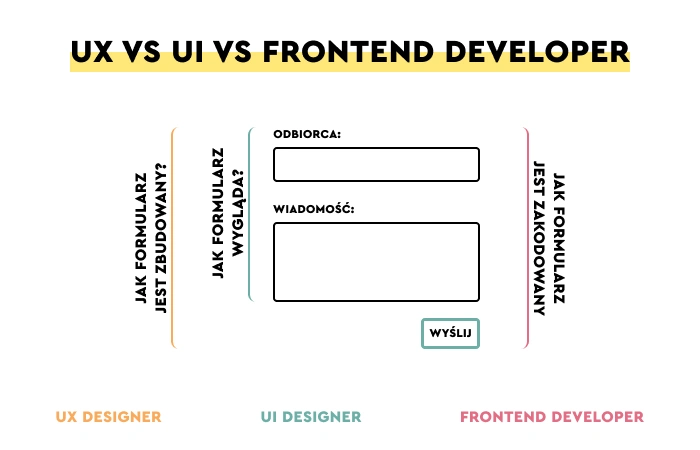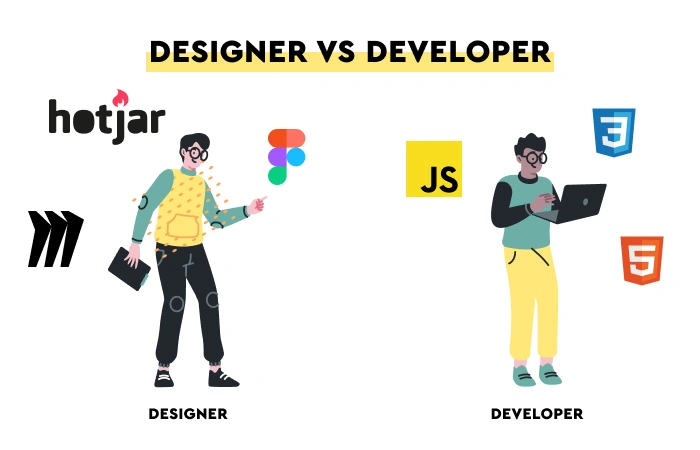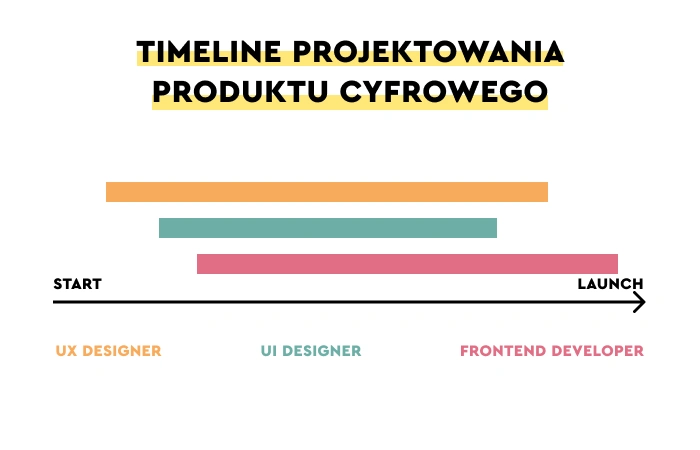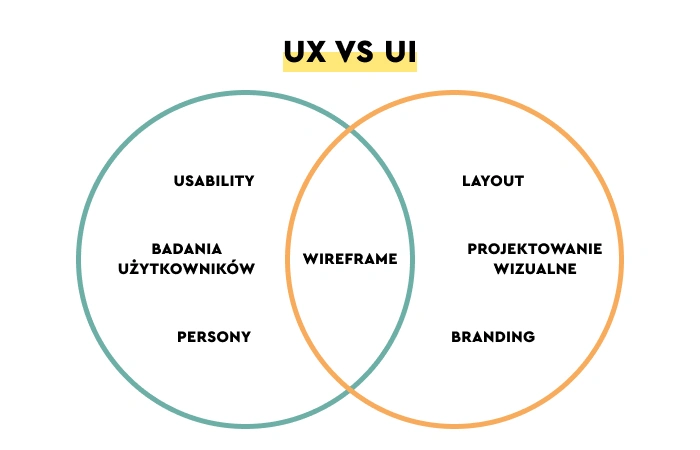You may also be asking yourself this question.
UI developer, web UI developer — with what roles, functions, scope of tasks, responsibilities, competencies, and experiences should you associate these terms? What are UI developer skills?
UI developers — who are they?
A UI developer is a user interface programmer. They're a technology-oriented specialist responsible for writing the code and providing an attractive and satisfactory UX design.
Is UI developer a new term used to name well-known positions and specialties?
Or is this some naming trend? And maybe it is an entirely new type of specialization?
What is the difference between a front-end developer and a UI developer?
What is the difference between a UI designer and a UI developer?
Are these differences similar to the distinctions between a UX designer and a product designer, which we wrote about in the article "What is a Product Designer?"
Following this trail of differences, similarities, and scopes of competencies, you can confidently ask: What kinds of skills (hard and soft) and experiences are expected from specialists employed in the position of UI developer?
You can also ask a very reasonable question: What role does a UI developer fulfill in the development or design team?
Is this a specialization similar to a full-stack specialization in which developers are responsible for creating both layers of an application, website, or web app that is both the front and back end?
This article will discuss all these matters, settle dilemmas, and discuss tasks that a typical UI developer handles.
We'll also discuss expectations that the market, owners of UX agencies, and web development companies have toward specialists designing user interfaces.
We cordially invite you to read on!
Who are UI designers?
Since there might be some confusion surrounding the roles of UI designers, UI developers, and front-end developers and their responsibilities, let us describe them.
UI designers focus on designing the appearance of user interfaces. They create concepts showcasing different screens that users will navigate. UI designers work with UX designers to create functional user interfaces that will be pleasant to use. They research users and implement best practices into their designs. User interface designers can also be responsible for creating prototypes to test how users interact with interface elements.
Who are front-end developers?
Front-end developers deal with the "front layer" of a website or software, including everything users see and interact with. They work closely with UI/UX designers and UI developers to create digital interfaces that meet users' and stakeholders' requirements. They're also responsible for designing navigation and ensuring that animation, videos, and graphics display correctly on a site.
In short, they monitor and maintain the functionality of a website or application.
How to define a UI developer?
The name of this position reveals all. A UI developer is a specialist who needs to have the competencies of a UI designer and a front-end developer.
In other words, they have a unique perspective that allows them to understand, feel (empathize), and use the potential of designing and coding.
A UI developer understands much more profoundly and broadly the limitations, risks, and dependencies that characterize both domains.

They also understand their nature when you try to combine them to offer end users the most satisfying experience (user experience). They're responsible for creating user interface elements.
The distinguishing trait of a UI developer is the ability to understand the uniqueness of designing and coding and effectively combining them. To communicate distinguishing features and attributes of a brand that are present in the end-user interface.
The position of a UI developer in organizations requires various soft and hard skills (in programming and designing).
Some time ago, design teams in which UI/UX designers worked and development teams in which front-end developers worked were strictly separated.
Today, this rigid division is blurred mainly because of the appearance of people in the market who can combine their knowledge and skills in these two fields.
UI developers are a combination, a common part of these domains, competencies, experiences, and skills.
And all in all, nothing is surprising about that. For some time now, the combination of interdependent, interconnected, and adjacent competencies has been a trend.
These specialists are incredibly desirable because they can bring a unique perspective to a company or a UX agency and offer added value.
What is the point of UI design?
Let's start with something obvious but worthy of mentioning.
The end-user graphical interface is the most direct element the user interacts with when using a web or mobile application.
The first impression effect, which we wrote about in the article "Designing a good first impression," appears, in most cases, during contact with digital product interfaces.
The extent to which they are assessed as attractive, friendly, inviting, and simple in the automatic and unconscious reactions will determine the course of further interaction.
From the perspective of a front-end developer who will ensure that the interface is maximally efficient and functional, attitudes appearing in fractions of seconds can be of minor importance. That is easy to dismiss as excessive psychologizing.

This problem is crucial and essential from a UI developer's standpoint (and also from a UI/UX designer's standpoint). It determines, to a large extent, what kind of relationship the digital product will manage to create with the user.
Will this be a love-hate relationship or a long-term relationship?
Remember that even the most functional interface that is unfriendly and unattractive can't build a long-lasting bond with the user. This bond translates into market, business, and economic success.
A UI developer's perspective is unique, simultaneously beneficial, and essential. Combining two crucial dimensions—design and coding—can add new and fresh value to the design.
To better understand the character of this combination, we need to briefly and illustratively describe the nature of the interface design.
What is a user interface?
What is an interface? It's a tool for communication. Thanks to interfaces, users can interact with a system — web or mobile application — to perform various tasks and achieve goals. They can communicate with an app, a system, or software.
An interface is a tool that enables users to use digital products. What does interface design involve? How an interface is designed and, thus, how it works powerfully influences how a digital product is seen, assessed, described, and treated.
End-users' interfaces make the navigation from point A to point B as short, simple, quick, and intuitive as possible.
Similar to navigation, which the user is familiar with, which they learned to use with other applications.
The task of a UI/UX designer is to design visual, functional, and interactive elements so that this process will be simple and pleasant for the user.
An interface needs to work according to habits, expectations, and needs. Or even better than that.
With that said, this added value, which goes beyond technical, aesthetic, and design attributes, is an ability to look at an interface as a tool people use.
With all associated consequences.
Regarding, for example, the fact that people make mistakes and have different perceptions, mental models, emotions, and attitudes.
Even though a developer can create a perfect technological interface that will execute functions as efficiently as possible, more is needed to make a liked and highly praised interface.
To do this, it's essential to have the competencies of a designer who understands these purely human needs, capabilities, limitations, and typical behaviors and who, based on research and test results, can face them.
The appearance, way of working, presentation, interactiveness, and accessibility of a user interface, to name a few of the important features, can't only result from a designer's personal preferences or biases but also from data, research, and a unique, specific approach to the design process.
At the end of this segment, we would like to remind you that an interface needs to have the following three features, it needs to be:
- Functional.
- Convenient and intuitive.
- Visually attractive (aesthetic).
In summary, specialists responsible for creating user interfaces use data acquired from UX research, thanks to which they can make interfaces technologically efficient and satisfactory in terms of user experience.
They can offer end users navigation elements that make navigation as effective, satisfactory, and error-free as possible.
UI developers have the skills, knowledge, and competencies of UI designers and developers. They can add value to interface design by making it more friendly and counteracting the negative effect of the first impression.
The role of a UI developer — the user interface developer
By combining two crucial competencies — technology and design — a UI developer, while creating a user interface, can translate design, graphical, aesthetic, and branding concepts related to usability into a technological language of specifics.
They can give them the most optimal and efficient form through appropriately adapted technology.

When the roles are separated, and different specialists work on the design and programming sides, it can be challenging to understand some nuances.
It takes time to achieve understanding and find a satisfactory compromise.
Understanding both sides' conditions, goals, methods, and limitations is valuable because it allows for better use of design and technology's potential.
Metaphorically speaking, thanks to UI developers, it's possible to achieve a valuable effect, the core of which is mutual intertwining.
Technology functionalizes design, and design humanizes technology.
A UI developer is also tasked with the following:
- Enhancing the experience of the user as a design problem
- Remembering business goals
- Finding the best possible ways of fulfilling the needs of business owners and end users through technology
- Analyzing customer flows
- Studying users' behavior
- Prototyping the user interface
- Designing interactions
- Creating mock-ups, prototypes, and MVPs
- Designing navigation systems
- Designing icons and graphical elements used in an app
- Ensuring the consistency of a graphical user interface (GUI) of digital products
- Coding
In summary, UI developers are specialists who have technical competencies (front-end) and design skills.
Their role is to orchestrate technology with usability and find simultaneously efficient and satisfactory solutions.
With that said, UI developers aren't UI designers or front-end developers.
They're specialists who — based on the cooperation of various factors and elements, resulting in an effect far exceeding the sum of the components — bring new quality and value to creating digital products.
While UI and UX designers work on the appearance of a user interface and the experience it offers, UI developers focus on programming these design concepts.
Hard and soft skills of UI developers
The usefulness of UI developers primarily depends on their range of hard and soft skills.
Hard skills that are most frequently desired in UI developers include the following:
- Knowledge of programming languages, technologies, and frameworks (e.g., React, AJAX, JQuery, JSON, HTML, CSS, JavaScript, Angular, Vue, Swift)
- Familiarity with UI development tools (e.g., MaterialUI, Chrome Dev Tools)
- Knowledge of tools used in creating prototypes (Adobe XD, Sketch, InVision, Axure, Figma)
- Familiarity with content management systems (e.g., WordPress, Joomla!, Drupal, Magneto, osCommerce)
- Knowledge of social media APIs
- Code optimization skills
Soft skills that are most frequently desired in UI developers include the following:
- Communication, interpersonal skills
- Creativity and openness
- Flexibility and curiosity
- Inquisitiveness and empathy
- Taste, aesthetic sense
- Ability to think analytically and synthetically
- Self-reliance and being goal and result-oriented
- Ease of learning — willingness to learn continuously is a crucial attitude the market expects from a UI developer
- Knowledge of agile methodologies
Front-end developer vs. UI developer
UI developer as a position, role, or collection of competencies is frequently confused or compared to the position, role, or collection of competencies of front-end specialists and programmers.
Naturally, these two roles have a lot in common; however, they aren't synonymous. Differences are apparent and can be boiled down to a few dimensions.
A front-end developer differs from a UI developer primarily in terms of the following:
- Scope of work — a front-end developer creates websites and applications, and a UI developer develops mainly interfaces for the product user.
- The main goal they want to achieve — a front-end developer mainly focuses on optimal integration of a digital product, and a UI developer aims at offering satisfactory interactions and experiences and increasing engagement of users.
- The extent of knowledge of technologies — a front-end developer has much broader technical competencies.
Moreover, user interface developers try to ensure that their interfaces are visually attractive and consistent with an organization's system design and branding.
To a large extent, front-end developers focus on the reliability of the interface, the smoothness of its operation, and integration with the back-end layer.
In other words, a UI developer and a front-end developer differ in proportions of responsibilities.
A UI developer focuses more on aesthetics and usability and pays less attention to technological issues. A front-end developer does the exact opposite. Their main concern is technology. Its efficiency, up-to-dateness, and security.
And you can't forget, as the authors of the article published on the Interaction Design Foundation blog, "User Interface Design," remind that users are quick to assess designs.
Interface creators—front-end developers and UI/UX designers—should remember that their primary goal is to combine usability, functionality, and attractiveness optimally.
UI developers, as they understand this need, bring to the design a perspective that doesn't allow you to forget that an interface should be:
- Effective and attractive.
- Not work-intensive but characterized by low interaction cost, the amount of work put into its operation should be minimal.
- Transparent — it should support the execution of tasks and shouldn't attract the users' attention with its form and aesthetic.
- Trouble-free and familiar.
- Satisfactory and frustration-free.
- An expression of values that a brand represents and realizes, for which it's famous.
- Perfect in a functional and technical sense, but it should also be "human" and evoke emotions.
What is a UI developer? Summary
- The graphical user interface (GUI) is the most direct element the user interacts with when using a web or mobile application.
- Interfaces allow users to interact with a system.
- Interfaces enable users to perform tasks and achieve goals.
- The first impression effect usually occurs during contact with digital products' interfaces.
- Even the most functional but unfriendly and unattractive interface won't be able to build a long-lasting bond with the user, which will condition the market and business's success.
- The term UI developer (user interface programmer) refers to technically oriented specialists responsible for writing the code and designing an attractive, UX-satisfying interface.
- A UI developer is a specialist who needs to have the competencies of a UI designer and a front-end developer.
- A UI developer has a unique perspective, which allows them to use the potential of designing and coding.
- Combining two crucial dimensions—design and coding—can add new and fresh value to the design.
- Combining interconnected competencies has been a clear trend for a long time.
- A UI developer designs and programs visual, functional, and interactive elements to make navigation easy and pleasant for the user.
- UI developers can add value by creating friendlier interfaces and counteract the negative effects of first impressions.
- When different specialists work on the design and programming sides, it can be challenging to find an understanding and a satisfactory compromise.
- Understanding both sides' conditions, goals, methods, and limitations is valuable because it allows for better use of design and technology's potential.
- UI developers aren't UI designers or front-end developers.
- They're specialists who bring new value to creating a digital product.
- A UI developer focuses more on aesthetics and usability and pays less attention to technological issues.
- In turn, a front-end developer does the opposite. Their main concern is ensuring the technology is efficient, up-to-date, and safe (e.g., digital services).






